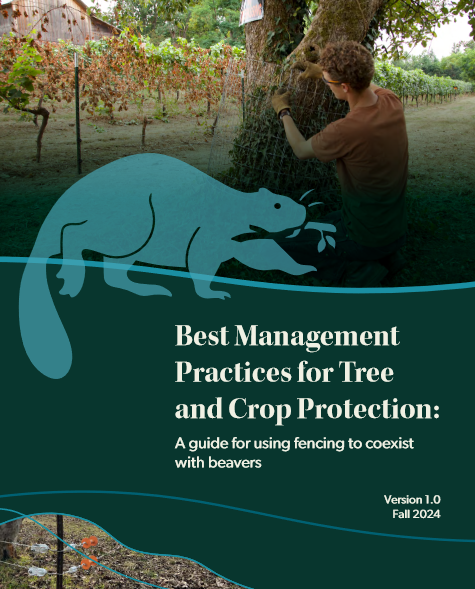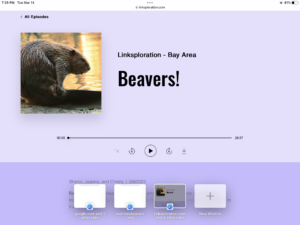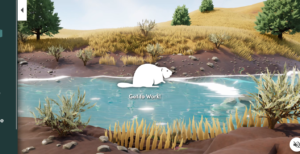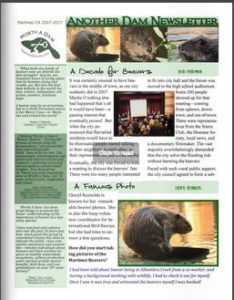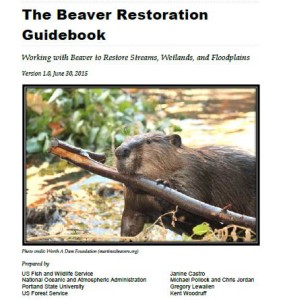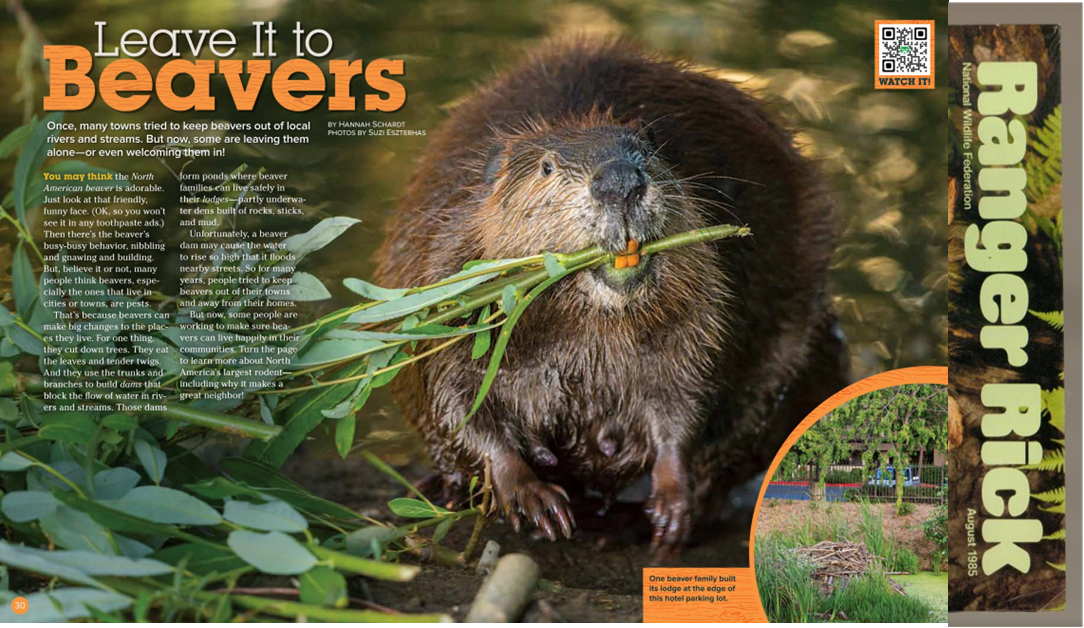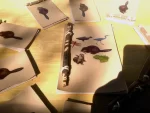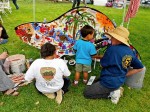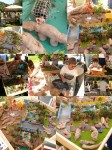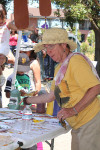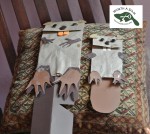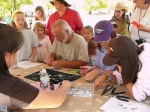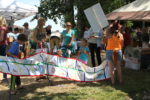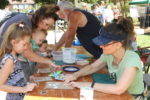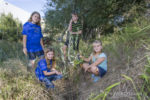I just realized that one of the things I love about this photo is that the way it’s taken makes Amy look like she’s IN the beaver pond, part of the scenery. Maybe like she’s just about to help that beaver build a dam when she’s done drawing. Amy-and-her-purple-crayon kinda thing.

Isn’t that just beautiful? The photo was taken lovingly by her husband who knows full well how to capture her beautiful creations. I am eager to see what she designs this year. Stay tuned because the premiere is due to come out very soon!
In other news about being up close at a beaver pond, we have a snippet about Skip Lisle leading an earth day beaver walk from the Bennington Banner.
Outdoors News in Brief
WILTON, N.Y.
Earth Day Beaver Education Program
 To celebrate the 49th Earth Day on Monday, April 22, Wilton Wildlife Preserve & Park and Saratoga PLAN are teaming up to offer a nature walk that is all about the largest rodent in North America, New York State’s official animal; the Beaver!
To celebrate the 49th Earth Day on Monday, April 22, Wilton Wildlife Preserve & Park and Saratoga PLAN are teaming up to offer a nature walk that is all about the largest rodent in North America, New York State’s official animal; the Beaver!
Environmental Educators from the Preserve & Park will be joining with nationally renowned beaver expert, Skip Lisle to lead this family-oriented walk. The walk will leave from the Meadowbrook Parking area of the Bog Meadow Brook Nature Trail and explore the wetland habitats that are created and maintained by this fascinating animal.
Participants will learn about the importance of the beaver to the exploration and settlement of our region, about its natural history, about how it is one of the few animals to be able to manipulate the environment to create its own habitat, and about the efforts that Saratoga PLAN has gone through to help keep the beavers as residents of the Bog Meadow wetlands. Space is limited and registration is required by April 18.
I want to go! That sounds amazing! Touring beaver habitat with Skip Lisle sounds like the perfect thing to do on Earth Day. Oddly that was something I never go to do in Martinez. He was a little intimidated by the attentive beaver public. And we didn’t know him well enough back then talk him into going down to watch the beavers – although we did have him over for a spaghetti dinner because I was hoping to keep him from lowering the dam too much.
Something tells me he would have been delighted to see a community watching beavers together.
 Not sure yet of the best beaver-y way to celebrate your earth day this year? There’s an upcoming beaver management online course featuring Jakob Shockey of Beaver State Wildlife Solutions. I know it’s not the same as being at a beaver pond with Skip, but Jakob was trained by Mike Callahan who was trained by Skip, so its almost the same thing. The class is free but you need to sign up in advance for this webinar:
Not sure yet of the best beaver-y way to celebrate your earth day this year? There’s an upcoming beaver management online course featuring Jakob Shockey of Beaver State Wildlife Solutions. I know it’s not the same as being at a beaver pond with Skip, but Jakob was trained by Mike Callahan who was trained by Skip, so its almost the same thing. The class is free but you need to sign up in advance for this webinar:
Ecosystem Restoration Deep Dive with Jakob Shockey: Collaborating with Beaver for Ecosystem Restoration
Jakob Shockey is an expert in riparian ecosystem restoration and beaver ecology, restoration, and conflict mitigation. He is the Restoration Program Manager for the Applegate Partnership and Watershed Council in Oregon, and the owner of the wildlife conflict mitigation company, Beaver State Wildlife Solutions.
In this deep dive, we will hear of the keystone role that beaver play in ecosystem function in the northern hemisphere. We’ll also hear how their eradication has disrupted ecology and hydrology, and how their reintroduction has led to restoration of these ecosystem functions.
While the beaver’s collaboration is invaluable as we seek to restore ecosystem function, often their hydrological designs conflict with our land use and infrastructure. Jakob will also discuss various conflicts that commonly arise, often leading to dead beavers, and how he and others mitigate these conflicts with innovative methods, enabling the beaver to stay in place and repopulate without flooded basements and blocked culverts.
When: Apr 23, 2019 11:00 AM Pacific Time (US and Canada)
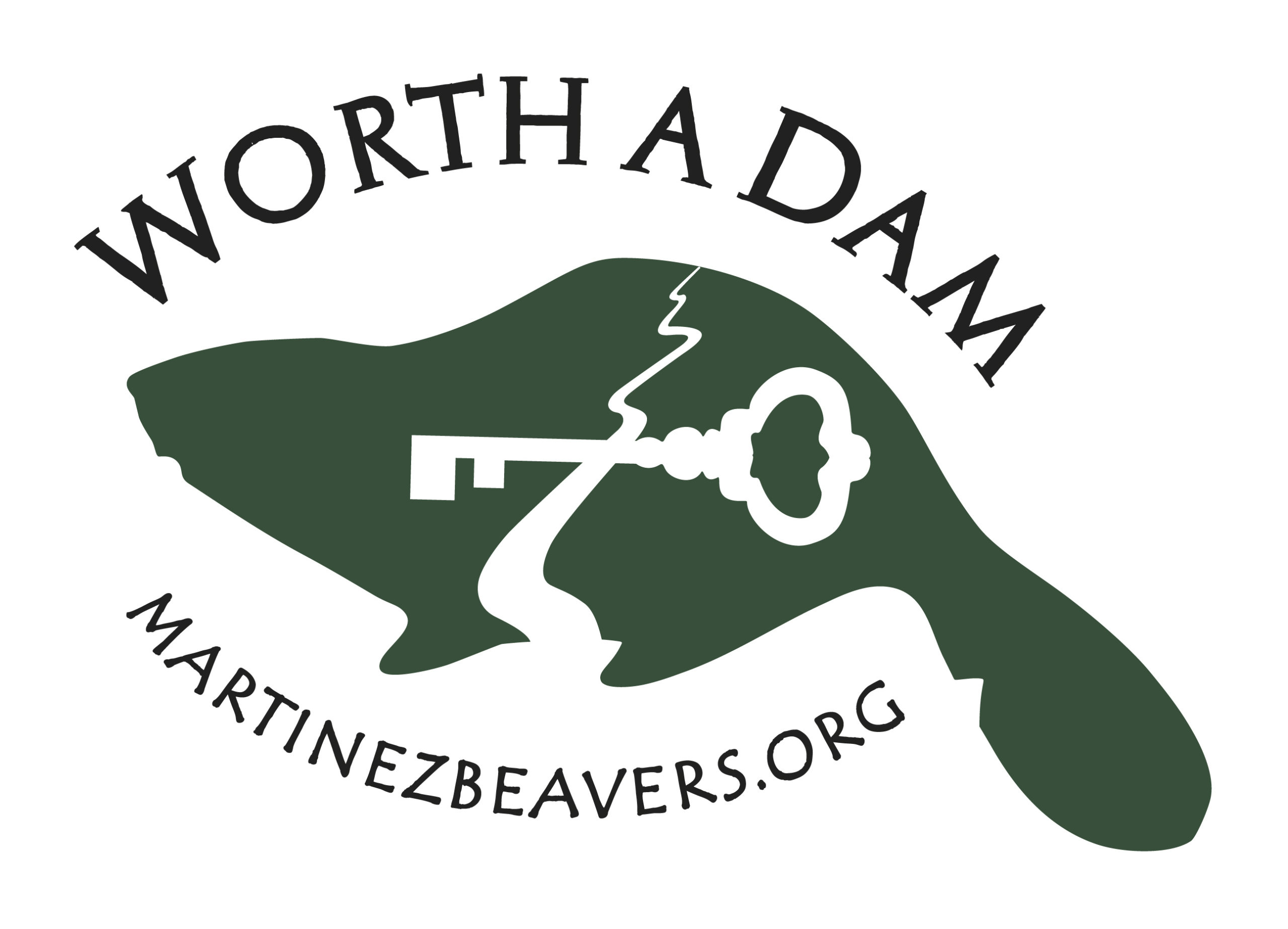




 Beaver are so important and have so many benefits for other species, including many species that are now imperiled, that Defenders works to restore them to places where they will create and enhance habitat for all the other critters we also care about. In the Rocky Mountains, boreal toad and native cutthroat trout are some examples of the imperiled species benefiting from our beaver restoration projects.
Beaver are so important and have so many benefits for other species, including many species that are now imperiled, that Defenders works to restore them to places where they will create and enhance habitat for all the other critters we also care about. In the Rocky Mountains, boreal toad and native cutthroat trout are some examples of the imperiled species benefiting from our beaver restoration projects. It’s not easy being a beaver in some places. In urban areas, such as cities or towns, beavers sometimes cause conflict by building dams which cause unwanted flooding, or by taking down charismatic trees which people value. In many cases these “nuisance” beavers are killed because of their actions, but sometimes simple tools can be used to prevent these conflicts, create more acceptance of their presence by people, and keep beaver where they are. For example, to prevent beaver from felling trees they can be wrapped in fencing or painted with a mix of sand and paint. Beaver, just like us, don’t like the “gritty” feeling of sand when chewing. To minimize flooding, flow-devices can be installed which limit the water level of beaver ponds by using a combination of pipes and fencing.
It’s not easy being a beaver in some places. In urban areas, such as cities or towns, beavers sometimes cause conflict by building dams which cause unwanted flooding, or by taking down charismatic trees which people value. In many cases these “nuisance” beavers are killed because of their actions, but sometimes simple tools can be used to prevent these conflicts, create more acceptance of their presence by people, and keep beaver where they are. For example, to prevent beaver from felling trees they can be wrapped in fencing or painted with a mix of sand and paint. Beaver, just like us, don’t like the “gritty” feeling of sand when chewing. To minimize flooding, flow-devices can be installed which limit the water level of beaver ponds by using a combination of pipes and fencing.




 Projects to relocate beavers to threatened habitats across the Pacific Northwest, such as the Methow Beaver Project, aim to restore and make such areas more resilient. New research indicates beavers and their dams may be a natural check against some impacts of climate change.
Projects to relocate beavers to threatened habitats across the Pacific Northwest, such as the Methow Beaver Project, aim to restore and make such areas more resilient. New research indicates beavers and their dams may be a natural check against some impacts of climate change.






